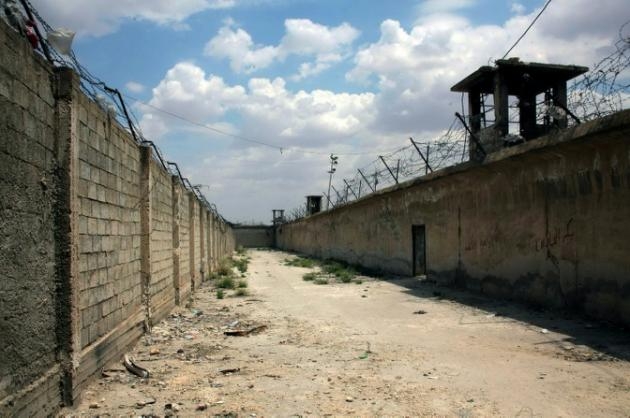Tens of thousands forcibly disappeared in Syria: Amnesty

The Syrian government has forcibly disappeared at least 65,000 people since the beginning of the crisis in 2011, according to a new report released by Amnesty International on Thursday.
Starting with crackdowns on protesters, activists and lawyers at the beginning of the uprising, the Syrian security apparatus has swallowed up many thousands of civilians - including more than 3,000 children - during the course of the uprising and ensuing war, the report states.
Amnesty’s report claims these horrific figures “reflect an orchestrated campaign of forced disappearances” and, as “part of an organised attack against the civilian population” in Syria, amount to a crime against humanity.
The Syrian Network for Human Rights, a monitoring group based in Syria, has documented the names of 65,116 people - including 58,148 civilians - believed to have been forcibly disappeared since March 2011.
Amnesty has meanwhile recommended that the situation in Syria be referred to International Criminal Court (ICC) prosecutors, while urging all states to attempt to exercise universal jurisdiction to investigate the many violations of international law committed in Syria.
Although non-state armed groups and militias are known to have also disappeared and kidnapped individuals, Amnesty does not cover these crimes in the new report.
She thought she and her family were safe
On 9 March 2013 Syrian Military Intelligence turned up at the home of Rania al-Abbasi and Abdul Rahman Yasin. The couple have six children, with ages ranging from two to 14 years old. Rania is a dentist who has represented Syria in international chess tournaments.
On their first visit, intelligence took Abdul Rahman away. On the second, the same troops stripped the house of money and jewellery before confiscating papers related to Rania’s clinic. On the third day, though, they came for Rania and the children.
“[Rania] thought she and her family were safe,” her sister, Naila, told Amnesty International, “because they had not participated in any political activities or belonged to any opposition party.”
In 2015, the Abbasis’ whereabouts are still unknown, despite rumours and conjecture. The reason for their arrest is also unknown to this day, although some believe she is one of many aid workers and medical physicians who have been targeted by the regime for purportedly helping “terrorists.”
Shady, a Palestinian-Syrian refugee from Yarmouk camp in Damascus, has previously told MEE he fled the country because he was wanted by Syrian intelligence for owning a pharmacy in the camp. They suspected him of treating and aiding Free Syrian Army (FSA) fighters present in the camp at the time.
The authorities arrested him once. But when they came a second time, Shady fled.
The logistics of forced disappearances
According to Amnesty International, all four branches of Syria’s security apparatus (namely military intelligence, air force intelligence, political security and general security, otherwise known as state security) are thought to carry out forced disappearances.
This is in addition to the Iranian-formed National Defence Forces (NDF) and the shabeeha, shadowy government-affiliated militiamen whose name translates as “ghosts” or “gangsters” in Syrian Arabic.
The shabeeha gained notoriety at the start of Syria’s uprising against the Assad government for their brutal crackdowns on pro-democracy protests, during which activists, protesters or civilians might be picked up and thrown into Syria’s labyrinth of detention facilities.
Hassan Jweyd, a baker from Aleppo who was known for leading the chants in his neighbourhood during the early days of the revolution, was arrested at his home by the Syrian army on 5 April 2012.
Shot in the leg during his arrest, Jweyd was taken to a hospital in the city. His brother, Ahmed, pleaded with the authorities.
However, after treatment, Jweyd fell into Syria’s detention estate, although the authorities denied he was in custody.
Sightings from released detainees placed Jweyd at the Military Intelligence Branch 215 in Damascus. But in January 2014, Ahmad learned from a military officer that his brother had been transferred again - this time to an underground facility somewhere in Damascus. Since then his family has heard no news.
“He was singing in the demonstrations. He just wanted to share his energy,” Ahmad said. “He was the youngest of us all. We cannot forget him.”
Networks of 'middlemen'
Given the numbers and scale of Syria’s trend of forced disappearances, a kind of black market racket has emerged, in which people pay networks of “middlemen” for information about their loved ones. These middlemen are thought to be close to the authorities and “buy and sell information on the whereabouts of disappeared detainees,” the report notes.
Amwar al-Bunni, a Syrian human rights lawyer speaking from Turkey, said: “In each neighbourhood there are several middlemen. It is the newest profession for Syrians...There are hundreds of famous ones, and thousands of people who are doing this.”
The cost of bribes can vary from a few hundred to tens of thousands of dollars, although no outcome is ever guaranteed.
Some interviewed by Amnesty recounted how, even after paying intermediaries, they did not receive accurate information or a change of situation for their disappeared loved ones. People have sold land and even their homes to gain information from the authorities.
Those that cannot afford the bribes must simply wait for news.
“Nobody is released for nothing,” said Ahmad, brother of Hassan Jweyd. “You have to have money to do it. I don’t have the connections, and I don’t have the two million Syrian pounds [around $10,500] I need to pay the bribe to find him and get him out.”
In other cases, family and friends of the disappeared found their loved ones through a cache of more than 50,000 photographs smuggled out of Syria by a defector codenamed “Caesar,” who worked for Assad documenting the people tortured to death by government forces.
Ahmad, a Syrian teacher living in Cairo who asked for his real name to be withheld, has previously told MEE that he identified the body of a close friend from the photos, in lieu of any information from the authorities.
“We found one of our friends in the photos. We didn’t know what had happened to him, but then we saw him when the photos were released.”
Ahmad’s friends agreed not to tell the parents of the deceased friend, but word eventually got out. The parents then wanted to see the photograph.
“His body was so thin, lying there with his mouth open,” Ahmad said. “Ah, we’re used to it now.”
Others simply wait in limbo for news of loved ones, some of them now missing for several years.
However, in a conflict where international law is routinely flouted and disobeyed by all sides of the conflict, it remains to be seen whether the trend of forced disappearances will stop, or if those responsible can be held accountable.
New MEE newsletter: Jerusalem Dispatch
Sign up to get the latest insights and analysis on Israel-Palestine, alongside Turkey Unpacked and other MEE newsletters
Middle East Eye delivers independent and unrivalled coverage and analysis of the Middle East, North Africa and beyond. To learn more about republishing this content and the associated fees, please fill out this form. More about MEE can be found here.




